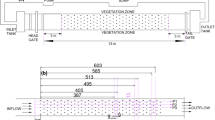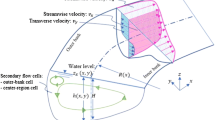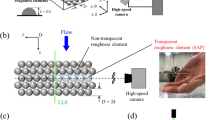Abstract
The operating conditions of the sedimentation tanks are very critical for wastewater treatment. The effects of operating parameters (inlet velocity, inlet sludge concentration and reflux ratio) on the settling performance of a vertical sedimentation tank (VST) are investigated using Mixture and RNG k-ε numerical simulation methods. In order to verify the suitability and accuracy of the selected numerical model, the experimental values are compared with the simulated values and the results show that the average relative error is 8.63%. That means the selected numerical model are reliable for describing the flow behavior of the VST. The simulation results indicate that the inlet velocity, inlet sludge concentration and reflux ratio have significant influences on the settling performance of the VST. When the inlet velocity and the inlet sludge concentration are kept at the low level, the sludge has enough time to settle down. However, the sludge easily flows out from the tank since the inlet velocity and the inlet sludge concentration are sharply increased. Meanwhile, the reflux ratio should be kept at the appropriate level to prevent the suspending sludge. Therefore, it is recommended to maintain the inlet velocity of below 0.3 mm/s, an inlet sludge concentration of below 2056 mg/L, and a reflux ratio of below 80% to ensure the effluent quality meets the Chinese discharge standards. In the future, the recommended operating conditions can be applied for large-scale vertical secondary sedimentation tanks without flocculation.













Similar content being viewed by others
Data Availability
Available.
References
Asensi, E., & Alemany, E. (2022). A hindered settling velocity model related to the fractal dimension and activated sludge flocs characteristics: Application to a sludge with a previous fragmentation and flocculation process. Separation and Purification Technology, 300. https://doi.org/10.1016/j.seppur.2022.121812
Bo, Q. (2012). Research on domestic wastewater treatment with radial flow inclined tube settling tank. Environmental Science and Management, 37(82–85), 116. https://doi.org/10.3969/j.issn.1673-1212.2012.04.021
Caughey, D. A., & Shmilovich, A. (1985). Multi-grid calculation of transonic potential flows. Advances in Computational Transonics.
Chen-Min, Y., Dai-Jun, Z., Pei-Li, L. U., & Zhen-Liang, L. (2004). The study and prospect of the secondary clarifier models in wastewater treatment. Journal of Chongqing University(Natural Science Edition), 3, 130–133.
Diehl, S., Farås, S., & Mauritsson, G. (2015). Fast reliable simulations of secondary settling tanks in wastewater treatment with semi-implicit time discretization. Computers & Mathematics with Applications, 70, 459–477. https://doi.org/10.1016/j.camwa.2015.05.005
Ekama, G. A., & Marais, P. (2004). Assessing the applicability of the 1D flux theory to full-scale secondary settling tank design with a 2D hydrodynamic model. Water Research, 38, 495–506.
Elhalwagy, M., Biabani, R., Bertanza, G., Wisdom, B., Goldman-Torres, J., McQuarrie, J., Straatman, A., & Santoro, D. (2021). Mechanistic modeling of peracetic acid wastewater disinfection using computational fluid dynamics: Integrating solids settling with microbial inactivation kinetics. Water Research, 201, 117355. https://doi.org/10.1016/j.watres.2021.117355
Gao, Z. (1997). Analysis of the Combined Sewage Discharge Standard and the discharge of wastewater from the tannery industry. China Leather, 26, 5.
Gao, H., & Stenstrom, M. K. (2018). Evaluation of three turbulence models in predicting the steady state hydrodynamics of a secondary sedimentation tank. Water Research, 143, 445–456. https://doi.org/10.1016/j.watres.2018.06.067
Grieves, C. G., & Stenstrom, M. K. (1976). Evaluation of performance of the Texas City refinery wastewater treatment facilities.
Guerrini, A., Romano, G., Carosi, L., & Mancuso, F. (2017). Cost savings in wastewater treatment processes: The role of environmental and operational drivers. Water Resources Management, 31, 2465–2478. https://doi.org/10.1007/s11269-017-1586-9
Guo, H., Ki, S. J., Oh, S., Kim, Y. M., Wang, S., & Kim, J. H. (2017). Numerical simulation of separation process for enhancing fine particle removal in tertiary sedimentation tank mounting adjustable baffle. Chemical Engineering Science, 158, 21–29. https://doi.org/10.1016/j.ces.2016.09.022
Jia, L. (2017). Effect of inlet-velocity on water flow distribution in horizontal-flow settling tank. Engineering Construction, 49, 60–62+66. https://doi.org/10.13402/j.gcjs.2017.10.012
Lainé, S., Phan, L., Pellarin, P., & Robert, P. (1999). Operating diagnostics on a flocculator-settling tank using fluent CFD software. Water Science Technology, 39, 155–162. https://doi.org/10.2166/wst.1999.0201
Lees, F. P. (1969). The determination of the moments of the impulse response of chemical processes from the basic transformed equations. Chemical Engineering Science, 24, 1607–1613.
Li, Z., Zhang, H., & Xu, G. (2022). Numerical simulation of the effect of sludge reflux ratio on flow field characteristics of radial secondary sedimentation tank. Chinese Society of Environmental Science 2022 Annual Scientific and Technical Conference - Environmental Engineering Technology Innovation and Application Session, Nanchang, Jiangxi, China, p. 8.
Li, B., & Stenstrom, M. K. (2014a). Dynamic one-dimensional modeling of secondary settling tanks and design impacts of sizing decisions. Water Research, 50, 160–170. https://doi.org/10.1016/j.watres.2013.11.037
Li, B., & Stenstrom, M. K. (2014b). Research advances and challenges in one-dimensional modeling of secondary settling tanks–a critical review. Water Research, 65, 40–63. https://doi.org/10.1016/j.watres.2014.07.007
Liu, Y. L., Zhang, P., & Wei, W. L. (2013). 2D simulation of effects of position of baffles on the removal rate of solids in a sedimentation tank. Applied Mechanics Materials, 253–255, 861–864.
Lotfiman, S., Bhattacharya, S., & Parthasarathy, R. (2022). A novel approach for measuring particle settling and settled bed build-up velocities in concentrated slurries using electrical resistance tomography. Powder Technology, 411. https://doi.org/10.1016/j.powtec.2022.117938
Patel, N., Ruparelia, J., & Barve, J. (2020). Prediction of total suspended solids present in effluent of primary clarifier of industrial common effluent treatment plant: Mechanistic and fuzzy approach. Journal of Water Process Engineering, 34. https://doi.org/10.1016/j.jwpe.2020.101146
Plosz, B. G., Weiss, M., Printemps, C., Essemiani, K., & Meinhold, J. (2007). One-dimensional modelling of the secondary clarifier-factors affecting simulation in the clarification zone and the assessment of the thickening flow dependence. Water Research, 41, 3359–3371. https://doi.org/10.1016/j.watres.2007.03.007
Ramin, E., Flores-Alsina, X., Sin, G., Gernaey, K. V., Jeppsson, U., Mikkelsen, P. S., & Plósz, B. G. (2014). Influence of selecting secondary settling tank sub-models on the calibration of WWTP models – A global sensitivity analysis using BSM2. Chemical Engineering Journal, 241, 28–34. https://doi.org/10.1016/j.cej.2013.12.015
Rao, P. V., Sivaramakrisna, K., Srivastava, R. K., Tiwari, R. P., Sudhakararao, B., & Satyanarayana, P. V. V. (2011). Integrated design of water treatment facilities: Susumu Kawamura. John Wiley & Sons, Inc.: New York, NY 1991. (pp. 658, ISBN 0–471–61591–9) $69.95 hardcover – ScienceDirect. Waste Management, 12, 101.
Shah, M. T., Parmar, H. B., Rhyne, L. D., Kalli, C., Utikar, R. P., & Pareek, V. K. (2019). A novel settling tank for produced water treatment: CFD simulations and PIV experiments. Journal of Petroleum Science and Engineering, 182. https://doi.org/10.1016/j.petrol.2019.106352
Shahrokhi, M., Rostami, F., Md Said, M. A., & Syafalni. (2013). Numerical modeling of baffle location effects on the flow pattern of primary sedimentation tanks. Applied Mathematical Modelling, 37, 4486–4496. https://doi.org/10.1016/j.apm.2012.09.060
Silva, J. F., Silva, J. R., Santos, A. D., Vicente, C., Dries, J., & Castro, L. M. (2023). Continuous-flow aerobic granular sludge treatment of dairy wastewater. Water, 15. https://doi.org/10.3390/w15061066
Taebi-Harandy, A., & Schroeder, E. D. (2000). Formation of density currents in secondary clarifier. Water Research, 34, 1225–1232.
Tan, M., Zhao, K., Wu, X., Liu, H., Shao, C., & Pan, B. (2023). Analysis on flow structure ina vortex pump under all flow rates. Water Supply, 23, 1874–1884. https://doi.org/10.2166/ws.2023.113
Tay, J. H. (1982). Development of a settling model for primary settling tanks. Water Research, 16, 1413–1417. https://doi.org/10.1016/0043-1354(82)90227-5
Van Doormaal, J. P., & Raithby, G. D. (1984). Enhancements of the simple method for predicting incompressible fluid flows. Numerical Heat Transfer Applications, 7, 147–163.
Xu, C. (2017). The numerical simulation on new type inclined plate of vertical flow secondary sedimentation tank. Bachelor's degree, Xi'an University of Science and Technology.
Yu, Y. (2016). Analysis on body stress by application of HyperMesh and Ansys WorkBench. Valve, 2, 17–18.
Yuhuan, B., Li, H., & Zhiyu, C. (2020). Design and selection of secondary sedimentation tank in municipal wastewater treatment plant. Sichuan Water Power, 39, 29–32.
Zhang, W., Zou, Z., & Sui, J. (2010). Numerical simulation of a horizontal sedimentation tank considering sludge recirculation. Journal of Environmental Sciences (China), 22, 1534–1538. https://doi.org/10.1016/s1001-0742(09)60285-0
Zhang, H., Liang, Y., Yan, X., Wang, B., & Wang, N. (2017). Simulation on water and sand separation from crude oil in settling tanks based on the particle model. Journal of Petroleum Science and Engineering, 156, 366–372. https://doi.org/10.1016/j.petrol.2017.06.012
Zhen, Z., Zhichao, W., Guowei, G., & Hong, H. (2008). Simulation and control of sludge blanket height in settling tanks. China Environmental Science, 3, 274–278.
Zhu, G., Zhang, Y., Ren, J., Qiu, T., & Wang, T. (2012). Flow simulation and analysis in a vertical-flow sedimentation tank. Energy Procedia, 16, 197–202. https://doi.org/10.1016/j.egypro.2012.01.033
Acknowledgements
The authors are very grateful for the financial support of Guangxi Overseas High‐level Talent “Hundred People Program”, Hong Kong, Macao and Taiwan Talented Young Scientist Program of Guangxi (HMTSP2021008) and Liuzhou Technology Development Project (2020NBBA0801).
Author information
Authors and Affiliations
Contributions
Xuan Wu contributed to the conception of the study and wrote the manuscript; Jiaqi Wei performed the experiments and data analysis; Lin Shen performed the model validation; Xueqin Li contributed to the manuscript preparation. All authors are in agreement with the content of the manuscript.
Corresponding author
Ethics declarations
Ethical Approval
Approved.
Consent to Participate
Approved.
Consent to Publish
Approved.
Competing Interests
The authors declare that they have no competing interests.
Additional information
Publisher's Note
Springer Nature remains neutral with regard to jurisdictional claims in published maps and institutional affiliations.
Rights and permissions
Springer Nature or its licensor (e.g. a society or other partner) holds exclusive rights to this article under a publishing agreement with the author(s) or other rightsholder(s); author self-archiving of the accepted manuscript version of this article is solely governed by the terms of such publishing agreement and applicable law.
About this article
Cite this article
Wu, X., Wei, J., Shen, L. et al. Investigation of the Influence of Operating Parameters on the Settling Performance of a Vertical Sedimentation Tank Through Computational Fluid Dynamics Simulations. Water Air Soil Pollut 235, 301 (2024). https://doi.org/10.1007/s11270-024-07110-8
Received:
Accepted:
Published:
DOI: https://doi.org/10.1007/s11270-024-07110-8




